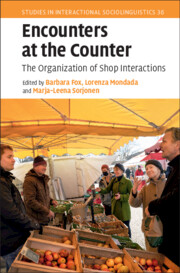Book contents
- Encounters at the Counter
- Studies in Interactional Sociolinguistics
- Encounters at the Counter
- Copyright page
- Contents
- Contributors
- 1 Encounters at the Counter
- 2 Approaching the Counter at the Supermarket
- 3 Customers’ Inquiries about Products
- 4 Offering a Taste in Gourmet Food Shops
- 5 Embodied Trajectories of Actions in Shop Encounters
- 6 Unpacking Packing
- 7 The Request-Return Sequence
- 8 Moving Money
- Appendix Transcription Conventions
- Index
- References
5 - Embodied Trajectories of Actions in Shop Encounters
Giving or Placing Products on or over the Counter
Published online by Cambridge University Press: 19 January 2023
- Encounters at the Counter
- Studies in Interactional Sociolinguistics
- Encounters at the Counter
- Copyright page
- Contents
- Contributors
- 1 Encounters at the Counter
- 2 Approaching the Counter at the Supermarket
- 3 Customers’ Inquiries about Products
- 4 Offering a Taste in Gourmet Food Shops
- 5 Embodied Trajectories of Actions in Shop Encounters
- 6 Unpacking Packing
- 7 The Request-Return Sequence
- 8 Moving Money
- Appendix Transcription Conventions
- Index
- References
Summary
The chapter examines the transfer of the item(s) from the customer’s hands into the hands of the seller. This transfer is a crucial part of many commercial transactions, as the seller must enter the item number into the shop’s inventory system, both to learn the price and to subtract the item from inventory. Exploring data from ‘kiosks’ or convenience stores across Europe, the precise details of this manual transfer of items are examined There are two general methods by which the transfer is enacted: in the first, the customer gives the item directly into the hand(s) of the seller; in the second, the customer places the item on the counter and the seller picks it up. Which method unfolds depends on a variety of factors, including the seller’s physical availability at the moment the customer approaches the counter, the kinds of items purchased, and whether the seller has anticipated the transfer by reaching out their hand, in a shape recognizable as ready to ‘take’. These two methods are seen to reveal the moral and commercial nature of the manipulation of objects, and ultimately of the transaction.
Keywords
Information
- Type
- Chapter
- Information
- Encounters at the CounterThe Organization of Shop Interactions, pp. 144 - 183Publisher: Cambridge University PressPrint publication year: 2023
References
Accessibility standard: Unknown
Why this information is here
This section outlines the accessibility features of this content - including support for screen readers, full keyboard navigation and high-contrast display options. This may not be relevant for you.Accessibility Information
- 2
- Cited by
